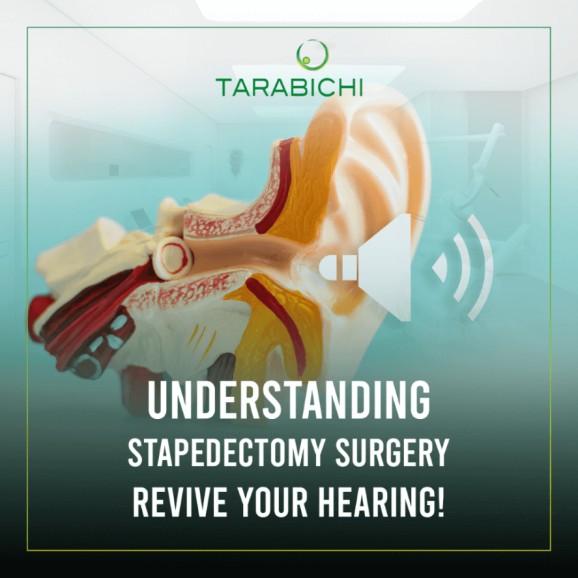Understanding stapedectomy surgery: Revive your hearing!
Contact Us
Have you ever wondered what would happen if your stapes bone got damaged? Undoubtedly it can cause hearing loss, so maybe you want to know more about stapedectomy surgery.
In this article; we’ll inform you with every single detail about stapedectomy treatment, what is it, its indications, and its complications.
What is stapedectomy ?
- What is a Stapedectomy procedure ? Stapedectomy is a surgical treatment for people with conductive deafness that resulted from damage in the stirrup (a small bone in the middle ear plays a crucial role in transmitting sound to the inner ear.
- During the surgery, the surgeon will make a small incision in the ear canal and remove the damaged or fixed stapes bone.
- An ear prosthetic device is then attached to the remaining bones in the middle ear and positioned to transmit sound vibrations to the inner ear.
What is the purpose of a stapedectomy ?
The main objective of stapedectomy surgery is to effectively treat conductive hearing loss (CHL).
Indications of stapedectomy
Unless the conductive hearing loss was the only indication of stapedectomy, there are some sub-indications that may be lead to the deaf need to be cured with stapedectomy surgery, here are some of them:
- Otosclerosis: A condition that causes the stapes bone to become fixed and unable to vibrate in response to sound waves.
- Trauma: A severe head injury or trauma to the middle ear can damage the stapes bone and cause conductive hearing loss.
- Congenital anomalies: Some individuals are born with abnormalities in the structure or function of the middle ear, which can cause conductive hearing loss.
- Chronic ear infections: Repeated ear infections can cause damage to the middle ear, including the stapes bone, which can lead to conductive hearing loss.
- Presence of an air-bone gap (ABG) around 10 dB.
What happens before a stapedectomy ?
Before a stapedectomy, the patient will typically undergo a thorough evaluation by an ear, nose, and throat (ENT) specialist to determine if the surgery is the appropriate treatment option for their particular case of conductive hearing loss, this evaluation may include:
- Medical history:
The doctor will review the patient's medical history, including any past ear infections, injuries, or surgeries, as well as any medications they are taking.
- Physical examination:
The doctor will perform a physical examination of the ear to look for signs of infection or other problems.
- Hearing tests:
The patient will undergo a series of hearing tests to determine the extent and type of hearing loss.
- Imaging tests:
The doctor may order imaging tests, such as a CT scan or MRI, to evaluate the structures of the ear.
Once the doctor determines that the patient is a good candidate for stapedectomy, the patient will receive instructions on how to prepare for the surgery, which may include stopping certain medications and fasting for a certain period of time before the surgery.
Also read:
What happens during stapedectomy ?
Stapedectomy is a surgical procedure that typically takes about 1-2 hours, and the steps of the procedure may vary depending on the surgeon's technique and the patient's individual case, but generally involve the following:
- The surgeon will make a small incision in the ear canal to access the middle ear.
- Removing the damaged stapes bone from the middle ear using microsurgical instruments.
- Preparing the remaining middle ear bones for the insertion of the prosthesis by smoothing out any rough edges and cleaning the area.
- Inserting a small prosthetic device, usually made of titanium or stainless steel, into the middle ear.
- The surgeon will close the incision in the ear canal using sutures or clips.
What to expect after a stapedectomy ?
After a stapedectomy, the patient can expect to experience some discomfort and hearing changes as they recover from the surgery.
Here are some of the common things that a patient may experience after the procedure:
Pain and discomfort:
Patients may experience some discomfort, pain, or tenderness around the ear and the incision site for several days following the surgery.
Hearing changes:
The patient may experience some temporary changes in their hearing, including muffled sounds, ringing in the ears (tinnitus), or reduced hearing.
Ear protection:
Patients should avoid any activities that could damage the ear, such as swimming or heavy lifting, for several weeks after the surgery.
Follow-up appointments:
Patients will need to attend follow-up appointments with their surgeons to monitor their progress and ensure that the prosthesis is functioning properly.
Rehabilitation:
After the initial healing period, the patient will need to undergo a rehabilitation process to learn how to use their new hearing and adjust to their improved hearing ability.
Complications of stapedectomy
Notwithstanding the fact that stapedectomy is safe surgery, it’s like any surgical treatment can carry some risks and complications, including:
- Hearing loss:
While the goal of the surgery is to improve hearing, there is a small risk of further hearing loss after the procedure if the prosthesis is not properly positioned or if there is damage to the inner ear during the surgery. - Dizziness and vertigo:
Some patients may experience dizziness or vertigo after the surgery, which can be caused by damage to the inner ear or changes in the balance system. - Tinnitus:
Tinnitus, or ringing in the ears, is a common side effect of stapedectomy. - Infection:
There is a risk of infection after any surgical procedure, including stapedectomy. - Prosthesis displacement:
The prosthesis that is inserted during the surgery may become displaced or dislodged, which can cause hearing loss or other complications. - Perilymph fistula:
It occurs when there is a leak of inner ear fluid through a small opening in the inner ear, which can cause dizziness, vertigo, or hearing loss.
What is difference between stapedectomy and otosclerosis surgery ?
Stapedectomy and otosclerosis surgery are both surgical procedures that are used to treat conductive hearing loss, but the two procedures are different in terms of their approach and the extent of the surgery.
While the Stapedectomy plays a critical role in treating the damaged ear using microsurgical instruments, Otosclerosis surgery, on the other hand, is more extensive, it involves removing or reshaping the affected bone in the middle ear using a variety of techniques, such as a laser or a small chisel, and may also use a graft to replace the removed bone
You may be interested in reading:
If you are looking for the Best ENT Doctor in Dubai or the Best ENT Surgeon in Dubai, please reach out to us on the below details, our team comprises of only the best ent doctors in UAE and the region.




